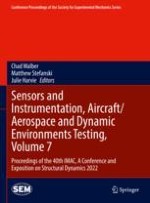2023 | Buch
Sensors and Instrumentation, Aircraft/Aerospace and Dynamic Environments Testing, Volume 7
Proceedings of the 40th IMAC, A Conference and Exposition on Structural Dynamics 2022
herausgegeben von: Chad Walber, Matthew Stefanski, Dr. Julie Harvie
Verlag: Springer International Publishing
Buchreihe : Conference Proceedings of the Society for Experimental Mechanics Series
